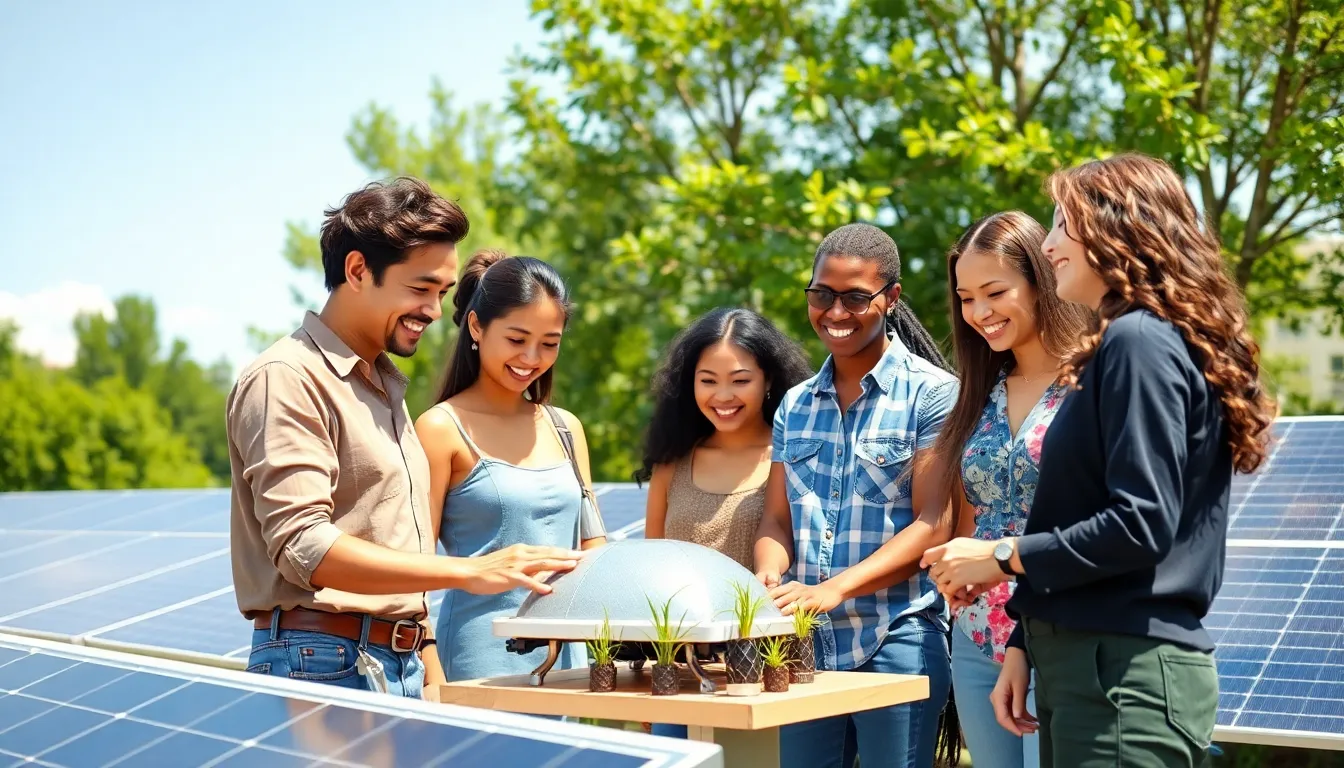In a world where gadgets seem to multiply faster than rabbits, sustainable technology steps in like a superhero with a green cape. It’s not just about solar panels and wind turbines; it’s a way of thinking that aims to make life easier while giving Mother Earth a well-deserved hug. Imagine a future where your smart fridge not only keeps your food fresh but also helps save the planet. Sounds like a sci-fi dream, right?
Sustainable technology is all about innovation that respects the environment. It’s the perfect blend of practicality and eco-friendliness. Whether it’s energy-efficient appliances or biodegradable materials, these advancements are changing the game. So buckle up and get ready to explore how this tech revolution is not just smart but also a little bit sassy, proving that saving the planet can be both fun and functional.
Table of Contents
ToggleDefinition Of Sustainable Technology
Sustainable technology refers to innovations designed to minimize environmental impact while enhancing quality of life. It encompasses a broad range of practices, including the development of energy-efficient systems and the adoption of renewable energy sources. Many examples exist, highlighting how these technologies integrate seamlessly into everyday life.
Products classified as sustainable technology often utilize eco-friendly materials, like biodegradable plastics or recycled substances. Energy-efficient appliances demonstrate how this technology reduces energy consumption, leading to lower utility bills and decreased carbon footprints. Innovative transportation solutions, such as electric vehicles and public transit improvements, contribute significantly to reducing greenhouse gas emissions.
Furthermore, sustainable technology promotes a circular economy, focusing on reducing waste through recycling and reuse. Systems designed for sustainability often emphasize longevity, ensuring that devices remain functional longer by using durable materials. Various industries, including agriculture and construction, apply sustainable practices, showcasing the versatility of this approach.
Sustainable technology is characterized by its ability to address societal needs while protecting the planet. By fostering innovations that enhance efficiency and reduce environmental harm, it seeks to create a balance between human activity and nature. Ultimately, sustainable technology represents a commitment to a greener future, emphasizing that progress and environmental stewardship can coexist.
Importance Of Sustainable Technology

Sustainable technology plays a crucial role in addressing pressing global challenges. By integrating eco-friendly practices into various sectors, it can drive positive change for the environment, economy, and society.
Environmental Benefits
Sustainable technology significantly reduces carbon emissions, promoting cleaner air and healthier ecosystems. Renewable energy sources like solar and wind power lower dependence on fossil fuels. Energy-efficient appliances decrease demand for electricity, which further conserves natural resources. Innovative materials such as biodegradable plastics help minimize landfill waste. Additionally, advancements in sustainable agriculture improve soil health and maintain biodiversity. Collectively, these benefits foster a more balanced relationship between technology and nature.
Economic Benefits
Investing in sustainable technology stimulates economic growth. Green innovations create jobs in emerging sectors, like renewable energy and waste management. Energy-efficient systems often decrease operating costs for businesses, allowing for reinvestment into further innovation. Additionally, the increasing demand for eco-friendly products opens new markets. Sustainable practices enhance brand reputation and attract environmentally conscious consumers. Overall, the economic advantages extend far beyond mere cost savings, benefiting entire communities.
Social Benefits
Sustainable technology enhances quality of life for communities. Access to clean energy resources improves health outcomes through reduced pollution. Moreover, sustainable practices encourage social equity by providing underserved populations with modern amenities. Education around eco-friendly technologies promotes awareness and responsibility towards the planet. Community-driven renewable energy projects empower individuals and foster local engagement. Ultimately, sustainable technology cultivates a sense of shared responsibility for future generations.
Key Examples Of Sustainable Technology
Sustainable technology encompasses numerous innovations that promote environmental health and improved living standards. Here are some key examples illustrating its impact.
Renewable Energy Sources
Solar energy systems utilize photovoltaic panels to capture sunlight, converting it into electricity. Wind turbines harness wind power to generate clean energy, reducing reliance on fossil fuels. Hydroelectric plants exploit water flow to produce electricity sustainably. Geothermal energy taps into the earth’s internal heat, providing a consistent energy supply with minimal environmental disruption. These renewable energy sources collectively reduce carbon emissions while promoting energy independence.
Sustainable Agriculture
Precision farming employs technology to optimize crop production and resource usage. This method uses data analytics to improve yields while minimizing water and pesticide usage. Vertical farming utilizes controlled environments and limited space to grow food efficiently, often in urban settings. Organic farming avoids synthetic chemicals, focusing on natural practices that enhance soil health and ecosystem balance. Agroforestry integrates trees and shrubs into agricultural systems, benefiting biodiversity and improving land productivity.
Green Building Practices
Energy-efficient designs optimize natural light and ventilation to lower energy consumption in buildings. Sustainable materials, such as recycled steel or bamboo, reduce environmental impact during construction. Green roofs and walls promote insulation and manage stormwater effectively. Smart home technology enables energy monitoring and efficient resource management, contributing to lower utility bills. LEED certification standards guide developers toward eco-friendly construction practices, ensuring a balance between functionality and sustainability.
Challenges In Implementing Sustainable Technology
Implementing sustainable technology faces several significant challenges that impact its adoption and effectiveness.
Cost And Investment
Investing in sustainable technology often requires substantial upfront capital. Businesses may hesitate to allocate funds for innovations with uncertain returns. Initial costs for renewable energy installations or energy-efficient systems frequently deter smaller companies. Long-term savings can become appealing, but many struggle to see immediate financial benefits. Organizations that do invest, however, often experience lower operational costs and enhanced brand loyalty. Government incentives and subsidies might mitigate financial barriers, proving essential in driving adoption. Industry collaboration can also reduce costs and share resources.
Technological Limitations
Technological limitations can hinder the widespread adoption of sustainable solutions. Innovations in core technology often evolve slowly, causing delays in implementation. Reliability issues may also arise, leading to concerns among potential users. For example, battery technology for electric vehicles continues to improve, but concerns about range and charging infrastructure remain. Additionally, some regions lack the necessary technical expertise to support advanced sustainable technologies. Compatibility concerns with existing systems contribute to hesitation around adopting new innovations. Addressing these limitations through research and development efforts is crucial for fostering growth in sustainable technology.
Future Trends In Sustainable Technology
Emerging technologies shape the future of sustainable innovation. Smart grids optimize energy distribution and consumption by utilizing real-time data analytics. Artificial intelligence enhances efficiency in renewable resources, predicting energy demands and adjusting accordingly.
Biodegradable alternatives aim to replace traditional materials in packaging and consumer goods. These innovations significantly reduce landfill waste and environmental pollution. Electric vehicles continue to gain popularity, supported by advancements in battery technology that increase range and decrease charging time.
Decentralized energy systems empower communities to harness local resources. Microgrids allow neighborhoods to generate, store, and manage energy independently, promoting energy resilience. Solar panels are integrating with building materials for seamless architectural designs, maximizing energy capture.
Sustainable agriculture relies on precision farming techniques that utilize data to minimize resource waste. Drones monitor crop health and optimize irrigation, leading to higher yields with less environmental impact. Vertical farming presents another futuristic approach, using controlled environments to grow food in urban areas efficiently.
Circular economy practices are gaining traction, encouraging recycling and reuse in product design. Companies increasingly focus on creating products with extended lifespans and minimal environmental footprints. Digital platforms facilitating product sharing support this shift, reducing overall consumption.
Collaboration between industries is crucial for scaling sustainable technologies. Public-private partnerships foster innovation and address common challenges like funding and technical expertise. As sustainability becomes a priority, businesses are incentivized to develop eco-friendly solutions that align with consumer values.
Growing awareness of climate change drives demand for sustainable practices across sectors. Educational initiatives raise awareness about the benefits of sustainable technology, encouraging wider adoption. These trends collectively contribute to a greener, more sustainable future.
Sustainable technology represents a vital shift towards a future where innovation and environmental responsibility go hand in hand. By embracing advancements that minimize ecological impact while enhancing everyday life, society can foster a healthier planet. The ongoing evolution of sustainable practices across various sectors illustrates the potential for significant change.
As awareness grows and collaboration among industries increases, the adoption of sustainable technology will likely accelerate. This not only addresses pressing global challenges but also cultivates a culture of shared responsibility. Ultimately, the pursuit of sustainability through technology is essential for ensuring a thriving world for future generations.



